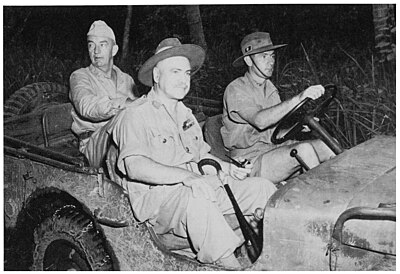
General Blamey tours the battle area with General Eichelberger (left).
(DA photograph)
requires a machete to cut through it. Knife-edged kunai grass up to 7 feet high, reeking swamps full of leeches and malarial mosquitoes, and a slippery ground surface under dripping vegetation add to the formidable obstacle course.
For the advance out of Buna the Japanese assembled a force of about 1,800 men augmented by 1,300 laborers from Rabaul and Formosa and 52 horses. This force proposed to cross Papua through the village of Kokoda, some 50 miles from Buna and over 100 miles from Port Moresby. Next to the village lay a facility highly valued by both sides: an airfield. Quickly moving inland, the Japanese met their first opposition late in the afternoon of 22 July. During the next two weeks, General Horii's troops defeated several Australian and Papuan units and took over the entire Kokoda-Buna Trail. When Horii received reinforcements on 18 August, he headed a well-supplied force of 8,000 Imperial Japanese Army troops and 3,450 naval troops.
By mid-August the two adversaries were inadvertently helping each other by relying on poor intelligence assessments. Caught off-guard by U.S. Marine landings in the Solomons, General Horii had to spread his resources over two fronts, Guadalcanal and Buna. But the
6
